Stephanie W., Low Entropy Volunteer Writer
Animals have played a crucial role in many scientific breakthroughs. After all, we have many similarities with lab rats, including sharing similar organ systems, around 85% of our DNA, and we are susceptible to similar illnesses and diseases. This allows scientists to observe how a vaccine, for example, would react in a human body without putting a human at risk. Although animal testing may seem like a good idea, it’s actually notorious for being inhumane, unreliable, expensive, and requires large amounts of manpower. Unfortunately, despite the numerous restrictions already in place to reduce the involvement of animals in experiments, millions of animals are still subjected to tests. As a result, there are currently around 50 alternatives to animal testing currently being studied, but only a few seem likely to be implemented. Here are some possible viable replacements for animal testing:
- Computer Modeling
It is also known as in silico tests. Computers and software now have the capability of predicting how a drug may react in a human body. Models of many organ systems can be used obtained from previous experiments and already known data in order to simulate the possible irritants and reactants caused by a drug. While they’re not a perfect substitute for animal testing, they’re capable of reducing the number of animals needed during experimenting.
- 3D Cell Culture and Organs-on-Chips
To understand our body, we need to see it as one large system with many interconnected parts. This is where the 3D cell culture comes in. With the help of a computer microchip, known as Organs-on-Chips, the model is capable of mimicking structures and functions of the human tissue as it would be within the human body. As a result, the model can predict the various effects of a drug on a living organ.
- In Vitro Cell Culture
In vitro cell cultures involve taking samples of cells from an animal or plant and growing it outside of the body in a controlled environment (usually a laboratory). These cells are important for observing the immediate and specific effects of a drug. Under the right conditions, the cells have the potential to last up to years outside the body, allowing the effects to be observed over a longer period.
- Organotypic Models
This testing method is a little more gory than the rest. It involves using organs obtained from slaughterhouses instead of live animals. Although no live animals are harmed using this method, there are many downsides. Given that the organs are from dead animals, its ability to replicate how a drug would work in a living being is significantly worse.
- Cell Based Tests and Tissue Modeling Tests
Cell-based and tissue modeling provide information on how the skin or tissue possible irritants or reactions an ingredient might evoke. These models are developed using human skin obtained from surgery and post-mortems (tissue obtained after a person’s death) and can be used as a substitute for rabbit irritation tests. During testing, the skin is stretched so that it replicates the skin of a living person.
Alternatives to animal testing is becoming a more viable option, as it is equally as accurate, more cost-effective, and easier to carry out. With more and more new alternatives being discovered, the possibility of eliminating animal testing altogether seems hopeful. Animal testing has led to so many lives being saved, but technologies have advanced far enough for it to be our turn to save theirs.
–
Leave your thoughts for Stephanie in the comments below — better yet, start up a dialogue with the Low Entropy community in person at a Conscious Connections meeting or online at our community site. You can also follow us on Facebook, Instagram, TikTok, Twitter and YouTube to stay up-to-date with Low Entropy news!







